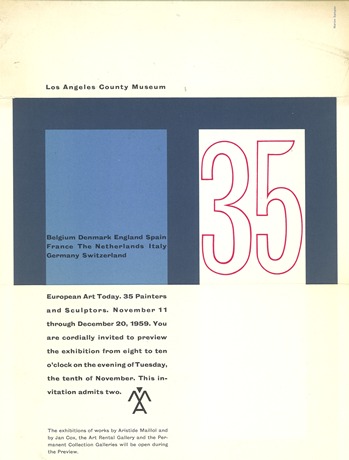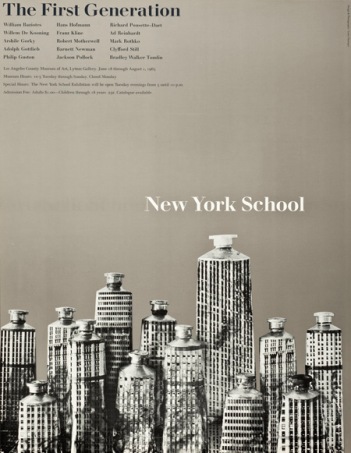We know you might want to see the megalith destined to be part of Michael Heizer’s Levitated Mass as it makes its journey through L.A., so we want to give you an overview of your chances. As mentioned previously, the actual transport (made possible by Hanjin Shipping) starts tonight and will only occur in the middle of the night—and slowly at that. During each day it will be parked in specially identified areas. (You can see the overall route map here, and Google street views in the links below.) These daytime stops will be your best and most convenient opportunities to see the boulder during this historic movement. With that in mind, here is a detailed breakdown of its stops, plus a few tips and recommendations for each location. (Some are more convenient than others.) As an FYI, none of these stops will result in daytime street closures, though in some cases there will only be one lane of traffic open in either direction.
Day or night, if you see the boulder during its journey, let us know! Post your pics to Facebook or Twitter and tag us (Twitter hashtag: #LevitatedMass). Check back to this blog post each day as we update its movement. We will also be updating news of the transport daily on the Levitated Mass page and on Twitter.

Megalith slated to become part of Michael Heizer’s Levitated Mass, prepared for transport to the Los Angeles County Museum of Art, 2012, © 2012 Michael Heizer, photo by Tom Vinetz
Wednesday, February 29: Following its initial departure from the quarry tonight, the boulder will travel about seven miles to the intersection of Mission Boulevard and Bellegrave Avenue in Glen Avon.
Tip for gawkers: The transporter will be parked on private property, though the area is fairly wide open.
Update, February 29, 8:27 am: Last night at about 10:40 pm, the transporter carrying the 340-ton megalith left the quarry in Riverside County. All went well on the first leg of the journey, which saw the transporter travel approximately five miles in four and a half hours. Nearly half of that time was spent making a sharp turn from Granite Hill Drive onto Country Village Road. As of now the transporter is parked at its planned first stop. The second leg of the journey will begin tonight and will take the boulder approximately ten miles to its second stop. Check out this video showing the transporter leaving the quarry!
Thursday, March 1: The boulder will arrive at its second stop near the southwest corner of Ontario Airport, at the intersection of Mission Boulevard and Grove Avenue. The transporter will be parked on private property—it will be easy to see, and traffic won’t be affected.
Tip for gawkers: The area is fairly desolate outside of an Arco gas station across the street and a couple of nearby aviation companies.
Update, Thursday, March 1, 6:17 am: Everything went very smoothly on the transporter’s second night. The transporter moved at a good clip, covering about eight miles. The boulder safely arrived at Mission Boulevard and Grove Avenue, near the edge of the Ontario Airport, at 4:15 am this morning.
Friday, March 2: You’ll find the transporter parked on Chino Avenue at Chino Hills Parkway in Diamond Bar. (Note: see update below!)
Tip for gawkers: These are both wide streets with fast-moving traffic and no parking. At best you can drive by, but it will be difficult to stop and look, or to get out of your car for a photo op.
Update, Friday, March 2, 7:34 am: The transporter traveled ten miles last night and is now parked near the Park and Ride on Chino Avenue near the 71 freeway. This is two miles short of the originally planned stop of Chino Avenue and Chino Hills Parkway. Emmert International, which is managing the transport, deemed this to be the safest, least disruptive stop. The transporter will remain here for the day until it resumes its journey tonight around 10-11 pm. It should make up those miles tonight and reach its next planned destination in Rowland Heights without disrupting the overall transportation schedule. Update, 9:37 am: Please be warned: today’s stop is not convenient for stopping and looking at the boulder. There is no nearby parking, and the street is very busy. We encourage you to see the boulder at its next stop in Rowland Heights, where it will be located all weekend.
Saturday/Sunday, March 3-4: All weekend the transporter will be parked on Pathfinder Road in Rowland Heights, near Fullerton Road. (To get here, take the 60 to the Fullerton Road exit and travel south to Pathfinder.)
UPDATE, Saturday, March 3, 9:45 am: The transporter successfully completed the most challenging part of the journey early this morning. CHP and local municipalities allowed extended drive time, and the transporter has now reached its destination at Pathfinder Road and Buttonwood Lane near Fullerton Road in Rowland Heights. It will remain there throughout the weekend.
Tip for gawkers: Make a day of it! The rock will be parked just across the street from Pathfinder Community Regional Park, which has tables, lots of grass, a play area, bathrooms, basketball and tennis courts, and more. Bring a picnic. Schabarum Regional Park is also nearby—a great place for hiking or biking. There’s also a lot of great cuisine in Rowland Heights. “Yes Plaza,” at the nearby intersection of Fullerton and Colima, is filled with sushi, Thai, tempura, and much more. You can also search Chowhound for more Rowland Heights recommendations.
Monday, March 5: You’ll find the rock on Leffingwell Road, just west of La Mirada Boulevard in the city of La Mirada, south of Whittier.
Tip for gawkers: If you’re using mass transit, the 120 bus will make a stop right next to the transporter. There is parking in nearby residential areas for a quick hop out of the car for a photo op. Leffingwell is a large, busy street with not a lot of foot traffic.
Update, Monday, March 5, 6:30 am: The transporter traveled approximately eleven miles last night from Rowland Heights to La Mirada, spending most of its journey on Colima Road. Early this morning it safely reached its next stop on Leffingwell Road, just west of La Mirada Boulevard. It will leave for the next leg of its journey at approximately 10–11 pm tonight.
Tuesday, March 6: The transporter pulls into the city of Lakewood, near Cerritos, on South Street at Palo Verde Avenue.
Tips for gawkers: There are strip malls on either side of the street with ample parking and a few fast food places to eat (and more food options at the nearby intersection of South Street and Woodruff Avenue).
Update, Tuesday, March 6, 6:10 am: The transporter departed La Mirada at approximately 10 pm last night and traveled nearly twelve miles to its next intended stop, South Street near Palo Verde Avenue in Lakewood, arriving at 4:30 am. It will leave for the next leg of its journey tonight around 10–11 pm.
Wednesday, March 7: The rock will spend the day in Bixby Knolls, a strip of small restaurants and other businesses in Long Beach. The transporter will be parked on Atlantic Avenue between 36th and 37th Streets.
Tip for gawkers: If you live in the Long Beach area, this is probably your best chance to see the transporter. If you’re coming around lunch or dinner, try Patricia’s Restaurant! It’ll have prime viewing of the rock, and the Mexican food is affordable and delicious. Of all the weekday stops, Bixby Knolls is the most densely populated, meaning there are a few more lunch or dinner options and other nearby things to do beyond a quick drive-by. For instance, continue south on Atlantic for about fifteen minutes and you’ll run into the Aquarium of the Pacific. [Update: the town of Bixby Knolls is getting into the spirit and throwing a Rock Party from 12-7 pm! More details here.]
Update, Wednesday, March 7, 6:12 am: The transporter had a short and uneventful journey last night, leaving the city of Lakewood at 10 pm and arriving to its intended destination of Bixby Knolls just three hours later. The megalith will be parked on Atlantic Avenue between 36th and 37th streets until approximately 10-11 pm, when it will leave for its next destination of Vermont Avenue and Carson Street. For information on the “Rock Party” in Bixby Knolls today from 12–7 pm, click here.
Thursday, March 8: After touring Long Beach in the middle of the night, the transporter will come to rest at Vermont Avenue just north of Carson Street, in the city of Carson (not far from UCLA Harbor Medical Center). (Note: see update below.)
Tip for gawkers: This stretch of Vermont will not be especially conducive to stopping, but there are residential streets nearby.
Update, Thursday, March 8, 7:03 am: Due to tight clearances along Atlantic Avenue, the transporter stopped three miles short of its intended destination. It is parked on Avalon Boulevard at Pacific Street, near Sepulveda Boulevard. It will depart tonight at approximately 10–11 pm with the intention of reaching its next planned stop at Figueroa Street, just north of Florence Avenue.
Update, 4:15 pm: The transporter will be leaving earlier than usual tonight, with an expected departure of approximately 8 pm.
Friday, March 9: From Carson the transporter will make its way to Western Avenue, for a more or less straight shot north, eventually parking itself at Figueroa Street, north of Florence Avenue, between 63rd and 65th Streets.
Tip for gawkers: If you live near USC this is a good chance to drive past the transporter and get a look at the rock. Its parking spot is just a few blocks south of Exposition Park, so you could also fit in a visit to the Natural History Museum, California African American Museum, or the California Science Center. This is a busy street lined mostly with houses and a couple of auto shops.
Update, Friday, March 9, 6:15 am: After an early start last night at about 8 pm, the transport made up the distance it lost from the night before. It covered just over sixteen miles, landing at its intended destination of Gage Avenue and Figueroa (just north of Florence Avenue) around 2:30 am. Tonight it makes its way to LACMA for the last leg of the nearly 105 mile journey. Learn more about what to expect for the final leg of the journey.
Finally, on Friday night the megalith will make its final leg of the journey, traveling up Figueroa (right past Exposition Park and USC), turning onto West Adams, then up Western, before turning onto Wilshire Boulevard and proceeding to its final destination at LACMA (and it is final—you better believe no one is moving this thing again!). This relatively short distance will take most of the night, starting at 11 pm and tentatively arriving to the museum around 4 am. We will be tweeting the Wilshire Boulevard journey if you happen to be awake!
Scott Tennent



 Posted by lacma
Posted by lacma 













